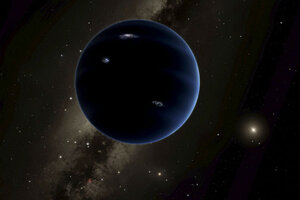Could 'Planet Nine' be a rogue planet?
A recent study argues that the hypothetical Planet Nine could have been lost by another solar system and then poached from the intergalactic wastes by our sun's gravity.

An artist's rendering shows the distant view from 'Planet Nine' back toward the sun, in this handout photo provided by the California Institute of Technology (Caltech) in Pasadena, Calif.
R. Hurt/Caltech/IPAC/Reuters
Ever since scientists proposed the existence of a "Planet Nine," astronomers have scoured the heavens for signs of the elusive body. But if the planet does exist, it is very far away, as searches have turned up no direct evidence of its current location and only hints as to an origin.
A recent study argues that the mysterious planet, if it does exist in the outermost reaches of the solar system, may have been a "rogue" that was captured by the sun's gravity.
The possible existence of Planet Nine was proposed by astrophysicists Michael Brown and Konstantin Batygin of the California Institute of Technology in January 2016. The researchers noticed that certain gravitational anomalies in the outer solar system could be explained by a massive planet lurking beyond the observed reaches of the solar system, around 20 times farther than Neptune's average distance from the sun.
But how could a planet 10 times larger than Earth wind up so far out?
A study presented at the 229th meeting of the American Astronomical Society in Grapevine, Texas last week proposed a solution. After creating 156 computer simulations of hypothetical rogue planets encountering our solar system, undergraduate James Vesper of New Mexico State University found it "very plausible" that Planet Nine could be a captured rogue, reported Space.com.
"A rogue planet is an object that formed like a planet from a disk around a star, like the planets in our own solar system," says Joshua Pepper, an astrophysicist and physics professor at Lehigh University who was not involved in the new study, in an email to The Christian Science Monitor. "However, if the planet passed nearby a much more massive planet early in its formation, before the orbits in its home system settled down, it could get slingshot out of its solar system, and would now be wandering through interstellar space in the Milky Way among the stars."
According to the study, the rogue planet got tossed out of the system by gravitational forces in 60 percent of the simulations – but in the other 40 percent, it got captured by the sun.
That would help to explain Planet Nine's distance, but it's still unlikely, says Michael Smutko, a professor of astrophysics and physics at Northwestern University who was not involved in the research.
"Imagine that the Sun was the size of an orange or an apple," Dr. Smutko tells the Monitor in an email. "Imagine the planets as maybe fruit flies buzzing around the apple-sized Sun. On this scale, the next closest star to the Sun, Proxima Centauri, would be another apple roughly 1,400 miles away! That's roughly Chicago to Tucson. Now imagine the chance of a fruit fly in Chicago making its way 1,400 miles and finding the apple in Tucson. It could happen, but it's not the way to bet."
Smutko prefers the theory that Planet Nine formed with the rest of the solar system.
"The 'classical' planets, Mercury, Venus, Mars, Jupiter, and Saturn are all easily visible to the naked eye and have been known for thousands and thousands of years," says Smutko. "Because these objects changed their positions in the sky night after night compared to the background stars (which never seemed to change), god-like attributes were given to the planets. In fact, the name 'planet' comes from the Greek word for 'wanderer.' "
After the invention of the telescope in the early 1600s, planets became less mysterious, helping to usher in a new era of inquiry during the Scientific Revolution. In 1609-1610, Galileo Galilei examined the phases of Venus through a telescope in order to provide scientific proof that the objects in the solar system orbit the sun and not the Earth, marking an important shift in humanity's perception of the universe.
"Those [discoveries of later planets] served to show people how expansive the universe was and how much there was to learn," Pepper says. "But it generally did not change the worldview of the civilizations that discovered them because those discoveries did not fundamentally change the picture of the universe they had, the way Copernicus and Galileo changed our understanding of the place of the Earth in the solar system, or the way Einstein changed our perceptions of space and time."
The study of planets continues to challenge preconceived notions of the solar system and our role within it. Even the demotion of Pluto from the status of planet to dwarf planet in 2006 forced scientists and the general public to reconsider what a planet is.
"If [Planet Nine] really exists, and is confirmed and observed, it will likely tell us that the process of planet formation is more violent, and chaotic, than previously thought," says Pepper. "And it would tell us that there is still a lot of space to explore where new discoveries may be lurking."

